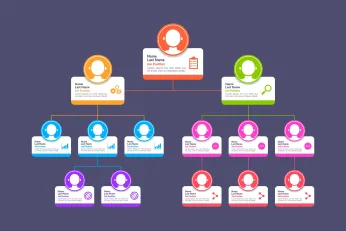عمولات البيع بالتجزئة لتعزيز المبيعات من خلال الحوافز
أطلق العنان لقوة عمولات البيع بالتجزئة وارتقِ بمبيعاتك إلى آفاق جديدة. تعلّم كيف يمكن للحوافز أن تحوّل نجاحك. ارفع مستوى المبيعات وتجاوز أهدافك.
في هذه الصفحة
تُعد عمولات البيع بالتجزئة إحدى أفضل الطرق للاحتفاظ بالموظفين في عالم تنافسي كالذي نعيش فيه اليوم. فعادةً ما يقرر هيكل عمولات مبيعات التجزئة ما إذا كان الموظفون سيبقون في المؤسسة أو سيستمرون في البحث السلبي عن مؤسسة تدفع أجراً أكثر تنافسية.
تساعد هياكل عمولات البيع بالتجزئة في تقدير إجمالي الأرباح المكتسبة أو الأرباح المستهدفة للموظفين. إلى جانب المزايا الأخرى مثل الحوافز أو المكافآت النقدية أو المكافآت غير النقدية، يمكن لأصحاب العمل إشراك موظفي مبيعات التجزئة وموظفي مبيعات التجزئة بفعالية.
في هذه المدونة، نسلط الضوء على عمولات مبيعات التجزئة المختلفة التي يقدمها أصحاب العمل لموظفيهم إلى جانب العوامل التي تؤثر على هيكل العمولة وطرق تنفيذها بنجاح في المؤسسة.
ما هي عمولة التجزئة؟
عمولة مبيعات التجزئة هي نسبة مئوية من قيمة المبيعات التي يحققها موظف المبيعات والتي يتم دفعها لموظف مبيعات التجزئة مقابل تحقيق حصة المبيعات أو الهدف الذي حدده صاحب العمل. وعادةً ما يتم تحديد عمولات البيع بالتجزئة بين 5 و45 بالمائة بناءً على نوع المنتج.
إذا تم تحديد الأجر الأساسي بمعيار الصناعة أو أعلى بقليل، فقد تبدأ العمولات من 5 بالمائة. لكن الطريقة الأكثر شيوعًا لدفع العمولات هي دفع متوسط الأجر الأساسي ونسبة مئوية أعلى من قيمة العمولة تتراوح بين 20 و30 في الم ائة، مما يساعد في تحفيز موظفي المبيعات على البيع أكثر من أجل كسب المزيد.
يمر موظفو المبيعات في قطاع البيع بالتجزئة بـ "الاستقالة الكبرى" - وهي فترة يستقيل فيها الموظفون من وظائفهم للعثور على وظائف أفضل تستحق أن يعملوا فيها. وقد استقال ما يقرب من 4 ملايين شخص من وظائفهم في عام 2021، مما يشير إلى ضعف هيكل المبيعات والرضا الوظيفي. ومن بين الأشخاص الذين استقالوا من وظائفهم، كشف 63% من الموظفين أن السبب الأهم هو عدم وجود تعويضات مرضية قد تشمل الأجور والراتب والعمولات والحوافز.
5 أنواع هياكل عمولة التجزئة
في مجال البيع بالتجزئة، تُعد العمولات والحوافز قوة دافعة لموظفي المبيعات وتتحكم في تعويضاتهم الإجمالية ورضاهم الوظيفي وفرص نموهم في الشركة.
استناداً إلى نوع الشركة ونوع دورة المبيعات أو المنتجات التي سيتعامل معها الموظف، يجب أن يُمنح الموظف نوعاً محدداً من هيكل العمولة.
فيما يلي بعض أكثر أنواع هياكل العمولات شيوعاً في السوق اليوم:
1. العمولة الثابتة
العمولة الثابتة هي شكل شائع من أشكال نظام العمولة في مجال البيع بالتجزئة للمتعاقدين المستقلين أو العاملين المستقلين ويتم دفع نسبة مئوية ثابتة من المبيعات بغض النظر عن حجم المبيعات التي يحققونها.
هذا النظام جيد بالنسبة للموظفين المتعاقدين ولكنه لا يصلح للموظفين ذوي الأداء العالي لأنه لا يكافئ إنتاجيتهم ولا يصلح للموظفين ذوي الأداء الضعيف.
من الأمثلة على هيكل العمولة الثابتة إذا كانت الشركة تقدم عمولة ثابتة بقيمة 100 دولار أمريكي للتوصية بمنتجات في معرض أو معرض أو كشك مثل المعارض والمعارض ومراكز التسوق وما إلى ذلك.
2. العمولة على أساس النسبة المئوية
هذا هو أكثر أشكال العمولة شيوعًا في قطاع البيع بالتجزئة. في هذا الهيكل، يُدفع للموظفين نسبة مئوية من حجم المبيعات كعمولة، مما يدفعهم إلى بيع المزيد وبالتالي يعود بالنفع على صاحب العمل. لا يعمل هذا الأسلوب بشكل جيد مع المنتجات ذات الأرباح العالية التي لا يمكن بيعها بأعداد كبيرة.
مثال على العمولة على أساس النسبة المئوية - تمنح الشركة عمولة ثابتة بنسبة 10 في المائة على أي حجم مبيعات يقوم به الموظف التنفيذي في متجر إلكترونيات. لذلك إذا حقق الموظف عملية بيع بقيمة 10000 دولار أمريكي، فإنه يحصل على 10 في المائة من 10000 دولار أمريكي، أي 1000 دولار أمريكي إضافية إلى راتبه.
3. عمولة متدرجة
هذا نظام عمولة مبيعات أكثر تطوراً وأكثر مكافأة لا يشجع فقط على البيع الأفضل، بل يمنح موظفي المبيعات ذوي الأداء العالي. العمولة المتدرجة لها شرائح مختلفة لحجم المبيعات أو القيمة وتمنح نسبة مئوية أعلى كلما ارتفعت القيمة.
على سبيل المثال - يمكن لمتجر سوبر ماركت أو متجر هايبر ماركت أن يحدد عمولة المبيعات لبيع 100 إلى 200 وحدة بنسبة 10 في المائة، ولكن بالنسبة إلى 200 إلى 300 وحدة، يمكن تحديد نسبة العمولة بـ 15 في المائة.
4. العمولة المتبقية
تعمل العمولات المتبقية بشكل أفضل مع خدمات البيع بالتجزئة ذات القيمة العالية أو الخدمات القائمة على العضوية التي تتطلب من العملاء تجديد عضويتهم أو عقدهم. وهذا يعني أنه يجب أن يبقى موظفو المبيعات على اتصال دائم لتحسين أرباحهم، وهي طريقة ممتازة للاحتفاظ بالعملاء.
يُدفع لموظفي المبيعات نسبة عمولة صغيرة ومقدماً ولكن يُدفع لهم أيضاً عمولات إضافية في كل مرة يجدد فيها العميل العضوية/ العقد/ أو الاشتراك من الشركة.
من الأمثلة الكلاسيكية لهذا النوع من العمولة في مبيعات البرمجيات - يحصل الموظفون على نسبة مئوية صغيرة من العمولة بناءً على عدد البرامج التي يبيعونها كل شهر، كما يحصلون على نسبة مئوية من العمولة عندما يجدد العملاء عضويتهم أو ترخيصهم.
5. المكافأة أو العمولة القائمة على الحوافز
يتم استخدام المكافأة وعمولة المبيعات والعمولة القائمة على الحوافز بشكل مختلف من قبل كل شركة.
قد تقدم بعض الشركات مكافآت أو حوافز إضافية لبيع مجموعة محددة من المنتجات التي تحقق نسبة عمولة أفضل من المنتجات الأخرى. قد تدفع بعض الشركات مكافآت إضافية أو حوافز إضافية على أساس الأداء عند بيع كميات كبيرة أو تحقيق أهداف أكثر من المستهدف.
يمكن رؤية مثال على هذا النوع من العمولات في مبيعات السيارات - معظم السيارات لها نفس النسبة المئوية من العمولة ولكن السيارة الأغلى ثمناً قد تكون لها نسبة مئوية أعلى مع مكافأة أو حافز إضافي لبيع هذا المنتج بعينه.
5 عوامل رئيسية يجب مراعاتها عند تصميم هيكل عمولة التجزئة
يبلغ معدل الدوران الحالي في قطاع البيع بالتجزئة نسبة صادمة تبلغ 60 بالمائة. إن ضعف العمولات وهياكل التعويضات هي السبب الأول لترك الموظفين لوظائفهم.
يمكن أن تؤثر العديد من العوامل الداخلية والخارجية على هيكل عمولة المبيعات التي قد تقدمها شركات البيع بالتجزئة لموظفيها. وبصفتك صاحب عمل، فإن دفع عمولة لموظفي مبيعات التجزئة من أكثر المعايير التنافسية في هذا المجال يساعد في الاحتفاظ بهم وإشراكهم في العمل.
فيما يلي بعض العوامل الرئيسية التي قد تؤثر على عمولة مبيعات التجزئة التي يقدمها أصحاب العمل:
1. أهداف المبيعات وأهداف الشركة
يجب وضع أهداف الشركة وموظفي المبيعات بطريقة تتوافق مع بعضها البعض. وعلى أساس أهداف المبيعات وأهداف الشركة، يمكن تحديد عمولات مبيعات التجزئة من قبل إدارة الشركة.
تركز بعض الشركات على حجم المبيعات الكبير، وقد تقدم هذه الشركات نسبة أقل من العمولة لأنها ترتبط بالمبيعات ذات الحجم الكبير. من ناحية أخرى، قد تقدم الشركات التي تركز على قيمة البيع عمولة أعلى لأن المنتج أو الخدمة قد تكون معقدة للغاية بحيث لا يمكن بيعها بحجم مبيعات كبير.
2. المقارنة المعيارية التنافسية
من العوامل الأخرى الأكثر أهمية التي تؤثر على عمولة التجزئة هي هيكل التعويضات أو العمولة التي تقدمها الشركات المماثلة أو المنافسين في السوق.
يجب على أصحاب العمل النظر في نوع نسبة العمولة التي تقدمها الشركات المنافسة الأخرى، وهيكل عمولة التجزئة التي يتم تقديمها وما إلى ذلك لإنشاء عرضهم الفريد لجذب الموظفين والاحتفاظ بهم.
كشفت دراسة أنه يجب أن يتقاضى الموظفون أجوراً أفضل قليلاً من الشركات المنافسة حتى يتم الاحتفاظ بهم لدى صاحب العمل لفترة أطول. فالشركات التي تدفع أجورًا تنافسية بنسبة 75 في المائة أقل بنسبة 50 في المائة من معدل دوران الموظفين في المبيعات.
3. هوامش الربح من المنتجات
عندما يتعلق الأمر بالبيع بالتجزئة، يتم تضمين العديد من أنواع المنتجات والخدمات المختلفة مثل السيارات، وتجارة التجزئة للمنتجات الاستهلاكية، والأزياء والملابس، والعناية بالبشرة ومستحضرات التجميل، والمجوهرات وغيرها.
تتمتع بعض المنتجات بهوامش ربح عالية كما في حالة بيع السيارات الفاخرة بالتجزئة. وفي شركات البيع بالتجزئة هذه، يتقاضى الموظفون في شركات البيع بالتجزئة هذه عمولة على أساس الربح.
من ناحية أخرى، قد تكون هوامش الربح في أسواق مثل السلع الاستهلاكية سريعة الدوران أو الملابس أو الإلكترونيات أقل، حيث تقدم هذه الشركات عمولة قياسية وهيكل أجور أساسي في الصناعة وتعتمد أكثر على المبيعات القائمة على حجم المبيعات أو هيكل العمولة المتدرج.
4. تعقيد عملية البيع
يمكن أن تشمل مبيعات التجزئة كلاً من المنتجات التي يسهل بيعها ولا تحتاج إلى أي دورات بيع معقدة، بينما هناك منتجات أخرى تتطلب تقنيات بيع معقدة وإعداداً. وعادةً ما تكون عمولة المنتجات التي يسهل بيعها مثل السلع الاستهلاكية الاستهلاكية والملابس بالتجزئة والإلكترونيات الصغيرة منخفضة - ما بين 5 إلى 15 في المائة.
المنتجات المتطورة التي تحتاج إلى موظفي مبيعات من ذوي الخبرة وشهور من التدريب كما في حالة بيع السيارات بالتجزئة وبيع السلع الفاخرة بالتجزئة والعلامات التجارية للأزياء وغيرها قد تكون نسب العمولة أعلى - عادةً ما بين 20 إلى 45 بالمائة.
5. تشجيع عمليات البيع الإضافي والبيع التبادلي
كما يمكن دفع العمولات للمساعدة في زيادة البيع والبيع المتبادل لتوسيع نطاق نمو الأعمال وزيادة الإيرادات داخل العلامة التجارية.
تُدفع عمولات المبيعات خصيصاً للموظفين الذين يستطيعون زيادة المبيعات لعملائهم من خلال عرض منتج أفضل بسعر أعلى وإقناعهم بشراء الأخير كما في حالة الهواتف أو أجهزة الكمبيوتر المحمولة.
البيع المتقاطع هو أسلوب لبيع منتجات أخرى ذات صلة من قطاعات أخرى من شأنها أن تكمل عملية الشراء مثل بيع سماعات الأذن أو سماعات الرأس أو حافظة الهاتف أو مكبر صوت البلوتوث أو غيرها من الملحقات ذات الصلة بالهاتف.
7 طرق كيفية تنفيذ هيكل عمولة التجزئة
بالنظر إلى أن هياكل عمولة التجزئة تتأثر بالعديد من العوامل كما ذكرنا أعلاه، فمن المهم أن تتوصل الإدارة إلى اختيار هيكل العمولة المناسب والاستراتيجية الأكثر فعالية لوضع العمولة في مكانها الصحيح.
تكشف الدراسات أنه في 60% من الشركات يتم إنشاء العمولات من قبل الإدارة العليا أو الرئيس التنفيذي بمساعدة مديري المبيعات. إليك طريقة بسيطة وفعالة لإنشاء وتنفيذ استراتيجية عمولة البيع بالتجزئة:
1. اختر هيكل العمولة المناسب
استناداً إلى نوع المنتج أو الخدمة ومدى تعقيد عملية البيع، يجب على الشركات اختيار نوع هيكل العمولة المناسب الذي ترغب في تقديمه لموظفيها. قد لا يستفيد جميع الموظفين من نهج "مقاس واحد يناسب الجميع".
2. ضع أهدافا واقعية
يجب تحديد الأهداف أو عروض الأسعار لموظفي مبيعات التجزئة من خلال الأخذ بعين الاعتبار هدف المبيعات الإجمالي للسنة وعدد موظفي المبيعات التي يجب أن يتم من خلالها تحديد أهداف واقعية كحصص مبيعات شهرية وربع سنوية وسنوية.
3. التواصل مع فريق المبيعات
يميل موظفو المبيعات في قطاع البيع بالتجزئة إلى التنقل كثيرًا، وهذا يعني أن الشركات قد تضطر إلى التعامل مع الموظفين الجدد كثيرًا. يساعد الحفاظ على وضوح الحصص وهيكل العمولة وتوصيلها بشكل فعال في تحسين إنتاجية الموظف.
4. إنشاء نظم فعالة للتتبع والإبلاغ
عادةً ما يفتقر الموظفون في مجال البيع بالتجزئة إلى التكنولوجيا اللازمة للإبلاغ عن بيانات مبيعاتهم وإنجازاتهم وتتبعها. تأكد من أن الموظفين لديهم الأدوات المناسبة لتسجيل إنجازاتهم اليومية في المبيعات وتنسيق التقارير المناسبة لذلك على أساس أسبوعي أو شهري.
5. النظر في الآثار الضريبية
تخضع العمولات للضريبة بموجب ضريبة الدخل ومعايير مصلحة الضرائب الأمريكية. وهذا يعني أنه يجب على أصحاب العمل اقتطاع الضريبة قبل دفعها كعمولات للموظفين. تأكد من احتساب مبالغ الضريبة بشكل صحيح وأن يتم إجراء هيكل العمولة الصحيح والدفع وفقاً لقوانين الضرائب لأصحاب العمل.
6. تتبع أداء الموظفين
يساعد تتبع أداء الموظفين الإدارة على تحديد المجالات التي تتطلب تدخلاً والمجالات التي يبلي فيها الموظفون بلاءً حسنًا. وهذا يساعد في تعديل هيكل العمولة أو تقديم تدريب إضافي أو حوافز مبيعات أو برامج مكافآت لمساعدة الموظفين.
7. التحسين المستمر
بصفتنا أصحاب عمل في مجال البيع بالتجزئة، يجب أن تكون الاستراتيجيات وهياكل الدفع ديناميكية وتتكيف مع ظروف السوق والمنافسة في الصناعة. يجب أن يشمل وضع الاستراتيجية والتأكد من استفادة جميع الموظفين منها أنشطة مثل:
- جمع الملاحظات من فريق المبيعات حول مستوى رضاهم فيما يتعلق بهيكل التعويضات والعمولات الحالي - وافق 63% من الموظفين على أن جمع ملاحظاتهم لخلق مكان عمل أفضل سيجعلهم أكثر حرصًا.
- التكيف مع ظروف السوق المتغيرة والتحقق من استراتيجيات تعويض المنافسين باستخدام أدوات تحليل المنافسين
- البقاء على اطلاع على اتجاهات الصناعة ووضع أحكام للمزايا النقدية وغير النقدية الأخرى للموظفين.
دراسات الحالة
- تُعد وول مارت واحدة من أكبر متاجر البيع بالتجزئة وتوظف أكثر من آلاف العمال. تهدف وول مارت إلى تقليل معدل دوران الموظفين في قسم المبيعات لديها ومساعدة الموظفين بمعايير أفضل للأجور وجودة العمل. تستخدم وول مارت العديد من المزايا والامتيازات للاستحواذ على الاحتفاظ بالموظفين وتحسين نوعية حياتهم بما في ذلك:
- تقدير الموظفين على أدائهم
- مزايا إضافية بناءً على التسلسل الهرمي
- أجور أعلى وحوافز أفضل قائمة على الأداء
- تأمين صحي يبدأ من 25 دولاراً أمريكياً في اليوم الواحد
- خصومات الموظفين وما إلى ذلك
- LL Bean هي شركة معروفة بملابس ومعدات المغامرات في الهواء الطلق، وقد واجهت تحديات في الاحتفاظ بالموظفين في حقبة ما بعد كوفيد. ولمواجهة ذلك، تقدم LL Bean مزايا مذهلة مثل:
- الأجور القياسية في الصناعة
- مكافآت نقدية
- الحوافز المرتبطة بالأداء
- خصومات كبيرة على البضائع والمنتجات
- البرامج الصحية والبرامج الخارجية وبرامج اللياقة البدنية وغيرها
- سداد الرسوم الدراسية
- التأمين الطبي والتأمين على الحياة وما إلى ذلك
استنتاج
موظفو التجزئة هم العمود الفقري لصناعة البيع بالتجزئة، ومع ذلك، هناك معدل دوران ومعدل دوران مرتفع للغاية يبلغ حوالي 60 بالمائة. وعلى الرغم من وجود العديد من الفرص في السوق في جميع الأوقات، إلا أن هناك أكثر من 1.86 مليون وظيفة شاغرة.
يقوم العديد من أصحاب العمل بتقليص عدد موظفيهم (بتخفيض 21% عن العام الماضي) بسبب نقص موظفي مبيعات التجزئة المدربين وذوي الخبرة الذين يمكنهم الاعتماد عليهم.
من خلال توفير تعويضات جيدة وهيكل عمولة تنافسي، يمكن لأصحاب العمل ضمان مشاركة الموظفين والاحتفاظ بهم بشكل أفضل. وقد كشفت الدراسات أن الموظفين الذين يتقاضون أجورًا جيدة ويحظون بالاحترام والتقدير الجيد لعملهم يكون لديهم موقف إيجابي تجاه العمل ومن المرجح جدًا أن يحتفظوا بوظائفهم.














